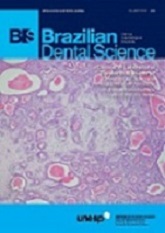Pleomorphic Adenoma versus Basal Cell Adenoma: An immunohistochemical analysis with b-catenin
DOI:
https://doi.org/10.14295/bds.2014.v17i1.944Abstract
The objective of this study was to investigate the distribution of b-catenin in pleomorphic adenomas and the basal cell adenomas to clarify its possible role in the etiopathogenesis of these two lesions. The expression of b-catenin (BD Transduction Laboratories) was analyzed by immunohistochemistry in formalin-fixed, paraffin-embedded specimens by the avidin-biotin-peroxidase complex method in 10 pleomorphic adenomas and 2 basal cell adenomas. The specimens were analyzed taking into account intensity, distribution and association with myoepithelial cells. The results showed that all cases of pleomorphic adenomas exhibited membranous and cytoplasmic immunostaining and the 2 cases of basal cell adenomas displayed nuclear staining. Higher b-catenin index rates were seen mainly in ductal structures of pleomorphic adenomas and in the nuclei of myoepithelial stromal and myoepithelial cells of solid clusters in basal cell adenomas. In conclusion, this immunohistochemical study may suggests the different degree of differentiation of the myoepithelial cells in these two tumors.
Downloads
Downloads
Published
How to Cite
Issue
Section
License
Brazilian Dental Science uses the Creative Commons (CC-BY 4.0) license, thus preserving the integrity of articles in an open access environment. The journal allows the author to retain publishing rights without restrictions.
=================




























